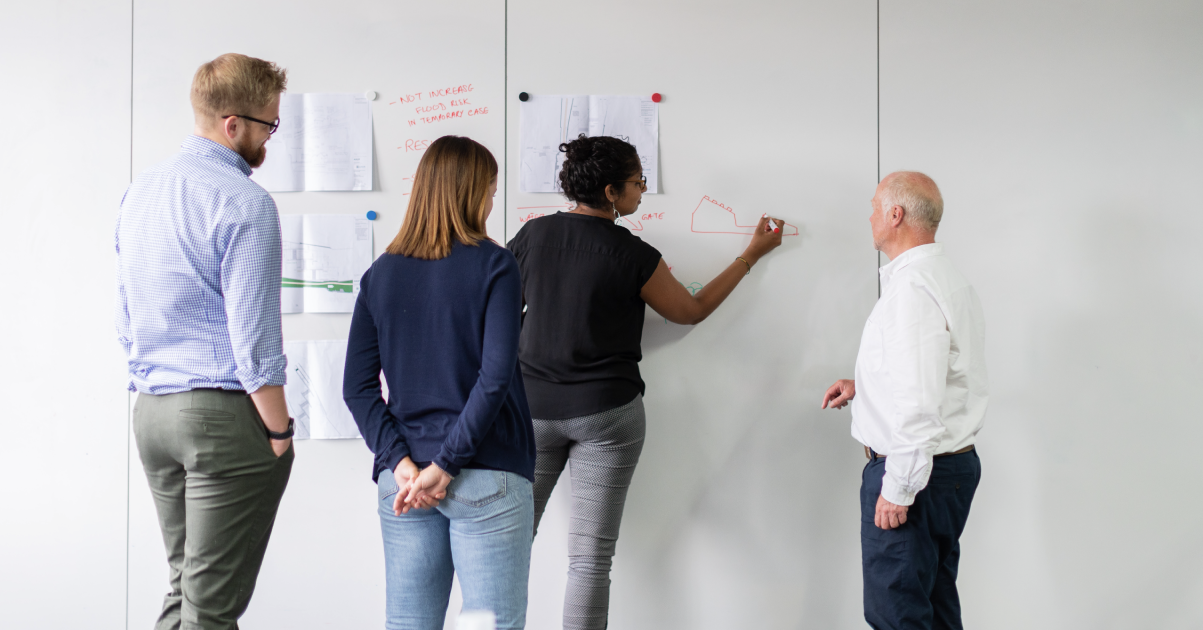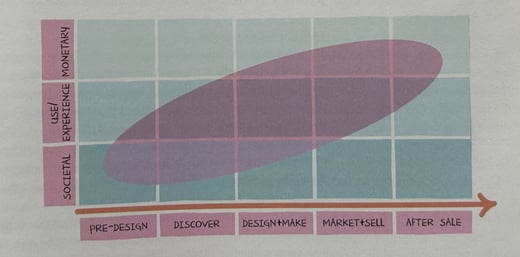
コ・クリエーションについては今日、積極的に語られています。しかし、コ・クリエーションには多くの意味があるため、それらの論議は混乱を招きがちでもあります。
たとえば、特定のツールやテクニックを使うことに対してコ・クリエーションという言葉を使う人もいます。同じ言葉をデザインリサーチの手法という意味で使う人もいますし、企業文化を形成するマインドセットとして使う人もいます。
私は、コ・クリエーションという言葉は、その3つのすべてでありえると思っています。
すなわち、ツールやテクニックの結集でもあり、デザインリサーチの取り組み方でもあり、企業文化を形成するマインドセットでもある、ということです。しかし、どこにどれだけの価値を見いだすかによって、それらが与える影響は変わってきます。
デザイン・開発のプロセスではここ10年から20年の間で変革が起こり、テーマの決まらない"あいまいな初期段階(fuzzy front end)"に時間がかけられるようになりました。これからの社会に必要なものを問い、探求する活動が行われるのが、まさにこの初期段階です。何がデザインできるのか、あるいは何を避けるべきなのかを、ここで決めるのです。あいまいな初期段階では、「人々のためにデザインする方法」、あるいは、「人々とデザインすることを考慮に入れてアプローチする」方法を取ることができます。デザインするにあたって、プロジェクトメンバーやデザイナーではない他の人々を自分たちのデザインプロセスに招き入れること、それこそが「コ・クリエーション」なのです。
 図表1:コ・クリエーションは、デザインと開発プロセスのあらゆるポイントで常に行われている
図表1:コ・クリエーションは、デザインと開発プロセスのあらゆるポイントで常に行われている
図表1の点が示すように、コ・クリエーションは、デザインと開発プロセスのすべてのポイントで行うことができます。しかし、すべてのプロセスにおいて「いつも行われている」とは限らないのです。
図表2では、デザインと開発のプロセスにおけるもうひとつの側面に言及します。ここでは、コ・クリエーションのプロセスで考えるべき3つのレベルの価値(マネタリーレベル、使用/経験レベル、社会レベル)が示されています。
 図表2:コ・クリエーションは、デザインと開発のプロセスにおけるさまざまなポイントで、異なる価値を生み出す
図表2:コ・クリエーションは、デザインと開発のプロセスにおけるさまざまなポイントで、異なる価値を生み出す
一番上のマネタリーレベルの価値は、ビジネスパーソンの間で、最も注目を集めてきました。この種のコ・クリエーションはお金を儲けることを目的にしていますが、必ずしもその企業と顧客を直接結びつける必要はありません。たとえば、クラウドソーシングを使って、顧客から商品、サービス、ブランドに対するフィードバックを得ることもできます。
使用/経験レベルの価値としてコ・クリエーションを使うのは、その企業が提供する商品やサービスを、人々のウォンツやニーズに、より見合っているようにしたいという気持ちからくるものです。結果的にリピート顧客を呼ぶことになれば、この種のコ・クリエーションは、金銭的な意味でも良い影響を与えることになります。
コ・クリエーションにおける社会レベルの価値は、長期的で持続可能な生活を目標とするものです。たとえば、「慢性的な病気を抱える人々のQOL(生活の質)を向上させるために、我々には何ができるのか?」といった、難しくて終わりのない疑問を掘り下げたりします。ここでは、専門家と一般人が密接に協力しあいます。この種のコ・クリエーションにおいては、専門家と一般人がダイレクトに関わり合うことが必要です。
図表2を見ると、マネタリーレベルの価値に重きを置いたコ・クリエーションは、マーケティング、セールス、ディストリビューションなど、デザイン開発プロセスの後期に起こりがちであることがわかります。使用/経験レベルを重視するコ・クリエーションは、デザインのプロセスで起こる傾向にあります。そして、社会レベルの価値を重視する場合は、デザイン開発のとても早い時期に始まって、デザイン開発プロセスの間もずっと続くのです。コ・クリエーションがデザイン開発の早い時期に起これば起こるほど、その影響は大きくなります。
図表2は、コ・クリエーションをどう適用するかにおいて、3つの異なるパターンを示します。「ツールとテクニックの結集」としてのコ・クリエーションは、商品やサービスのデザインが終わった後に、特定のツールやテクニックを適用することを指します。ブランドや、市場における新商品、新しいサービスに注目させる意味で、これは素早く、コストのかからない方法と言えます。
「デザインリサーチの取り組み方」としてのコ・クリエーションは、デザインにおいて参加型の方法を取ることに意義を置き、主に、発見とデザインを模索する初期段階に使われるものです。
「企業カルチャーのマインドセット」としてのコ・クリエーションは、あやふやなところから始まり、人々の生活に最も大きな影響を与える潜在性をもっています。もしも、すべての組織/すべての人々がコ・クリエーションのマインドセットをもつならば、それは非常に大きなインパクトを与えることでしょう。そのコンセプトは、全員が賛同するものではないかもしれませんが、小さな形で始まりつつも、時間をかけて、企業文化を形成するものに成長していくこともありえます。たとえば、マネタリーレベルで始められたコ・クリエーションの実践は、やがて使用/経験レベル、さらには社会的なレベルへと発展していくこともありえるのです。
Co-design is the topic of many discussions today. But these discussions can be confusing because co-designing has many meanings. For example, some people use the term co-design to refer to the use of specific tools and techniques. Others see it as an approach to design research. Still others talk about co-design as a mindset that describes the culture of a company. I will argue that co-designing can be all three: set of tools and techniques, an approach to design research and also a mindset of the company culture. But its impact will vary depending upon the perspective we take regarding its value.
The design and development process has transformed over the last 10 to 20 years with the growth of a large front end that is often referred to as the "fuzzy front end". It is here activities take place in order to inform and inspire the exploration of open-ended questions. In the front end of the design process we determine what could be (or should not be) designed.
The fuzzy front end can be approached from a designing for people or a designing with people mindset. When we invite people into the design process to design with us, we are taking the co-designing or co-creation approach.

Figure 1: Co-creation and co-designing are taking place at all points of time along the design and development process.
Co-creation can take place at every point along the design and development process as the dots in Figure 1 show. But it is not always used at all points along the process.
In Figure 2 another dimension has been added to the design and development process. Here three levels of value that can be adressed in the co-design process (monetary, use/experience and societal) are shown.

Figure 2: Co-designing provides different types of value at various points along the design and development process.
The monetary value of co-creation, the top level, has received the most attention in the business community. Co-creation that results in monetary value is aimed at making money. Co-creation at the monetary level does not necessarily require direct contact between the company and its customers. For example, crowd-sourcing can be used to obtain feedback from customers about products, services and brands.
The use/experience value of co-creation is fueled by a company's desire to transform consumers into users by ensuring that the products and services they offer will better meet people's wants and needs. Co-designing at the use/experience level may impact monetary gain if its application results in satisfied repeat customers.
The societal value of co-creation is aimed at longer term and more sustainable ways of living. It supports the exploration of big and open-ended questions such as "how can we improve the quality of life for people living with a chronic illness?" Co-creation at the societal level involves the integration of experts and everyday people working closely together. Direct personal involvement between such people is needed for this type of co-creation.
The shapes shown in Figure 2 reveal that co-creation with a focus on monetary value is more likely to take place later in the design development process, in the design adoption stages such as marketing, sales and distribution. Co-creation with a focus on the use/experience level tends to take place during the design process. And societal value co-creation starts in the very early front end and continues throughout the design and development process. So the earlier in the design development process that co-designing or co-creation occurs, the greater will be the likely impact.
Figure 2 shows the pattern of the three distinct applications of co-designing:
Co-designing as a collection of tools and techniques refers to the use of specific tools and techniques after the design of the product or service. This is a fast and low-cost way to drive interest in and attention to brands and/or new products and services in the marketplace.
Co-designing as an approach refers to the use of participatory methods in design. This application is used primarily during the discovery and design exploration phases.
Co-designing as a mindset has the most potential to impact the lives of people in the future since it starts in the fuzzy front end of the process. If the co-designing mindset is shared by all the people in the organization, its impact will be very large. However, the co-designing mindset may not be shared by them all. But it can start in small ways and grow to define the company culture if it is nurtured over time. For example, the adoption of co-designing practices might start at the monetary level and then move to the use/experience level and move, finally, to the societal level.
.png?width=160&height=100&name=Top_logo%20(3).png)


 図表1:コ・クリエーションは、デザインと開発プロセスのあらゆるポイントで常に行われている
図表1:コ・クリエーションは、デザインと開発プロセスのあらゆるポイントで常に行われている 図表2:コ・クリエーションは、デザインと開発のプロセスにおけるさまざまなポイントで、異なる価値を生み出す
図表2:コ・クリエーションは、デザインと開発のプロセスにおけるさまざまなポイントで、異なる価値を生み出す





